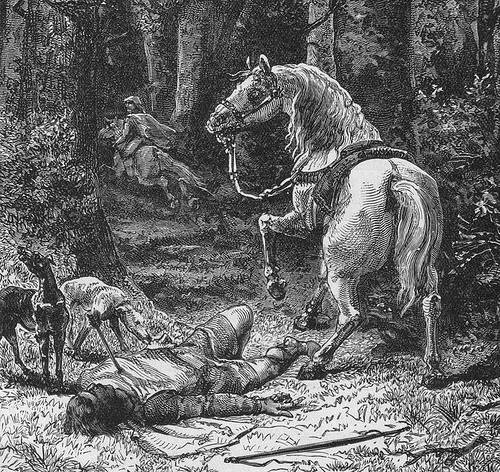On June 11, 1920, bridge expert Joseph Elwell was found dead in his Manhattan home, a bullet between his eyes. All the windows and doors were fastened except for Elwell’s bedroom window on the third floor. There was no evidence of a break-in, nothing of value was missing, and ballistics evidence ruled out suicide. The case has never been solved.
Death
Unrecorded

No one knows how Henry Hudson died.
A mutinous crew set the explorer adrift in Hudson Bay in 1611, and he was never seen again.
Isn’t It Romantic?

Dante Gabriel Rossetti revered his wife, and when she died in 1862 he laid his journal in her coffin.
Seven years later he decided he needed the poems, so he had her exhumed.
No Way to Go
Marcus Garvey suffered a stroke in January 1940, woke up to read his obituary in the Chicago Defender, learned that he had been “broke, alone and unpopular,” suffered a second stroke, and died.
Angry Planet
History’s 10 deadliest natural disasters:
- Yellow River flood, China, summer 1931: 1 million to 2 million dead
- Yellow River flood, China, September-October 1887: 900,000 to 2 million dead
- Bhola cyclone, East Pakistan, Nov. 13, 1970: 500,000 to 1 million dead
- Shaanxi earthquake, China, Jan. 23, 1556: 830,000 dead
- Cyclone, Coringa, India, Nov. 25, 1839: 300,000 dead
- Kaifeng flood, China, 1642: 300,000 dead
- Indian Ocean earthquake/tsunami, Dec. 26, 2004: 283,100 dead
- Tangshan earthquake, China, July 28, 1976: 242,000 dead
- Banqiao Dam failure, China, August 1975: 231,000 dead
- Aleppo earthquake, Syria, 1138: 230,000 dead
Six of the 10 occurred in China. See also Death Tolls.
Bad Actor

Molière collapsed on stage in 1673 and died hours later.
The play was called The Hypochondriac.
Postscript

Lawrence Sterne, after a lifetime of peculiarities, and becoming notorious as an eccentric, curious and able writer, at his death was buried in a graveyard near Tyburn, belonging to the Parish of Mary-le-bone, and the ‘resurrection man’ disinterred his corpse and conveyed it to the professor of anatomy at Cambridge where being laid upon the dissecting table, was at once recognized by one of those present who knew him well while living.
— Bizarre Notes & Queries, February 1886
Cold Case

A son of William the Conqueror, William II of England is remembered mostly for the curious manner of his death. In August 1100, William organized a hunting expedition in the New Forest. In sharing arrows with the Anglo-Norman nobleman Walter Tirel, he said, “It is only right that the sharpest be given to the man who knows how to shoot the deadliest shots.” That was tempting fate, apparently: The king did not return after the hunt, and his body was discovered the next day with an arrow piercing his lungs.
Walter fled to France, but chroniclers generally don’t consider him a murderer. He was a skilled bowman, unlikely to fire impetuously, and the abbot who sheltered him in France heard him swear repeatedly that he had not been in the part of the forest where the king was hunting. On the other hand, William’s brother Henry was also in the hunting party, and he stood to gain (and did) from William’s death.
So what really happened? We’ll never know.
Confirmed
Abraham de Moivre correctly predicted the date of his own death.
He noted that he was sleeping 15 minutes longer each day and surmised that he would die on the day he slept for 24 hours. That date, he calculated, would be Nov. 27, 1754.
He was right.
In Memoriam
Epitaph of John Laird McCaffrey (1940-1995), who lies in Montreal’s Mount Royal Cemetery:
John:
Free your body and soul
Unfold your powerful wings
Climb up the highest mountains
Kick your feet up in the air
You may now live forever
Or return to this earth
Unless you feel good where you are!
It was composed jointly by his ex-wife and mistress.
Read the first letter of each line.
